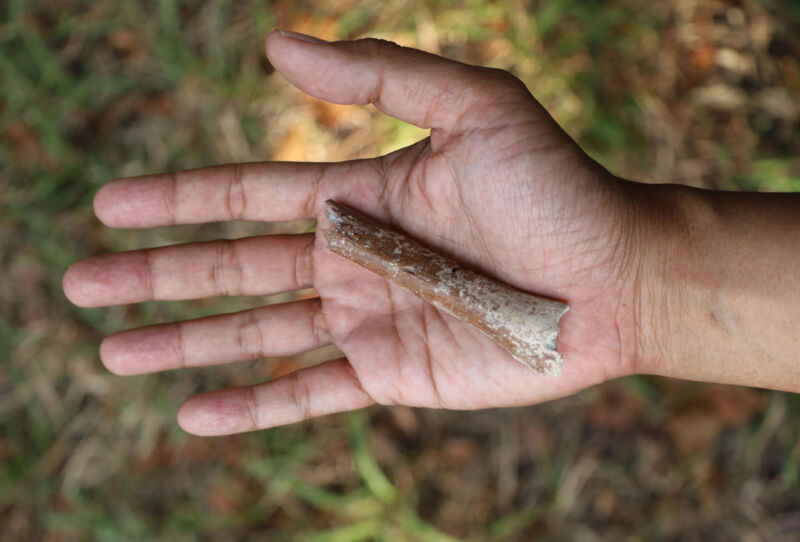
Yousuke Kaifu
The discovery of Homo floresiensis, often termed a hobbit, confused a lot of people. Not only was it tiny in stature, but it shared some features with both Homo erectus and earlier Australopithecus species and lived well after the origin of modern humans. So, its precise position within the hominin family tree has been the subject of ongoing debate—one that hasn’t been clarified by the discovery of the similarly diminutive Homo luzonensis in the Philippines.
Today, researchers are releasing a paper that describes bones from a diminutive hominin that occupied the island of Flores much earlier than the hobbits. And they argue that, while it still shares an odd mix of features, it is most closely related to Homo erectus, the first hominin species to spread across the globe.
Remarkably small
The bones come from a site on Flores called Mata Menge, where the bones were found in a large layer of sediment. Slight wear suggests that many of them were probably brought to the site by a gentle flood. Dating from layers above and below where the fossils were found limits their age to somewhere between 650,000 and 775,000 years ago. Most of the remains are teeth and fragments of jaw bone, which can be suggestive of body size, but not definitive. But the new finds include a fragment of the upper arm bone, the humerus, which is more directly proportional to body size.
The researchers argue that the bone is broken at roughly the mid-point of the humerus, meaning that the full-sized bone was twice its length. Based on the relationship between humerus length and body size, they estimate that the individual it came from was only a bit above a meter tall.
They also took a slice from the center of the sample and imaged the cells present in the bone when it fossilized. These suggest that the fossil came from a fully mature adult. That makes its dimensions, including the diameter of the bone, the smallest yet found. It is, to quote the paper, “smaller than LB1 (H. floresiensis) and any other adult individuals of small-bodied fossil hominins (Australopithecus and H. naledi.” So, even by the standards of small species, the new fossils belong to an extremely small individual.
As for what these individuals are related to, the answers are (once again) complicated. The morphology of the humerus is most closely related to the H. floresiensis individuals who resided on Flores hundreds of thousands of years later. Beyond that, it’s most similar to H. naledi. From there, its shape appears to be equally distant from various species, including both H. erectus and various species of Australopithecus. The teeth show a variety of affinities but are generally closest to members of the Homo genus.
So, the authors make two arguments. One is that the fossils come from the ancestors of the hobbits and belong to the same species, indicating that they inhabited Flores for at least half a million years. The second is that it’s a branch off the population of H. erectus, a species that was similar in stature to modern humans. The population would have evolved a shorter stature once isolated on Flores.
Nothing makes a lot of sense
That’s the argument, at least. There will undoubtedly be different opinions among paleontologists, however. Some had already argued that H. floresiensis was an offshoot of H. erectus and will be happy to accept this as new evidence. But the species is such a hodge-podge of features of earlier and contemporary species that it has been easy for others to make contrary arguments.
Even if those arguments were settled, there’s the issue of how it got there. Even at times of significantly lower sea levels, Flores would have required a significant ocean crossing from what is now Java, where H. erectus is known to have been present, and which was connected to Asia at the time. There’s no indication that any species that came before modern humans had developed boating technology, and some have suggested that the population was established on Flores after being swept there on tsunami debris. Once present, the island environment could have selected for a smaller body size.
But then there’s the issue of Homo luzonensis, which shared a similar body size but inhabited a very different island. That would seem to require a second event that was also unlikely: either a second ocean passage involving individuals from Flores or another ocean trip by H. erectus followed by similar evolution of smaller body size, despite a potentially different environment.
It’s clear that, while the new finds tell us something about the Flores population, they’re not going to settle any arguments.
Nature Communications, 2024. DOI: 10.1038/s41467-024-50649-7 (About DOIs).
